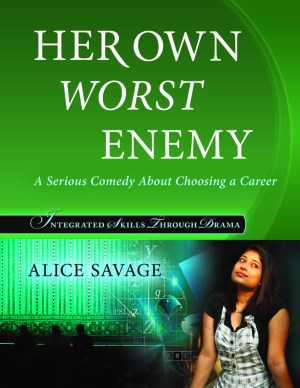Author Review of Her Own Worst Enemy: A serious comedy about choosing a career
Alice Savage, US
Alice Savage comes from a family of theatre people. Her grandfather was a professor of theatre arts, and her father is a playwright. She has a Master of Arts in Teaching from the School for International Training in Brattleboro, Vermont and is currently a professor of ESOL at Lone Star College System, in Houston, Texas where she also does some teacher-training. She is the author of many English language teaching materials. Her most recent book is Her Own Worst Enemy with Alphabet Publishing.

Alice Savage
2018, 72 pages
Alphabet Publishing
ISBN: 9781948492034
Learn more at: www.alphabetpublishingbooks.com/book/her-own-worst-enemy/

There’s a scene in Her Own Worst Enemy where a father is trying to convince his college-age daughter, Aida, to audition at The Julliard School, a famous performing arts school. Aida has other plans, however, and she pushes back. Trapped in a car with him, she threatens to open the door and jump out into traffic. He relents, but only briefly. He can’t help himself. He sincerely believes he knows what’s best for Aida even if she can’t see it herself. It is a scene familiar to any family with a college-age child. It is funny and affectionate. And it is not at all like dialogues one often sees in course books.
Yet realistic scenes such as this illustrate the power of theatre to offer content at the intersection of language and conversation. In a real conversation, speakers have a relationship and goals that inform their choices of what to say and how to say it. Sometimes the goals are the same, but often they are different. In the theatre, this is called rising tension—part of what applied linguists call pragmatics—and it can be mined for many different types of English language lessons.
Unfortunately, the dialogues we find in our books are often focused almost exclusively on demonstrating a grammar point or illustrating a set of vocabulary words. But students need to learn how to say things, just as much as they need to learn what to say. We are doing our students a disservice if they aren’t learning pragmatics and strategies to use language to achieve their goals. That is a major reason why I wrote Her Own Worst Enemy.
Her Own Worst Enemy is a short play about Aida’s struggle to choose between her love of science and her talent for acting. The seven-character play is six-scenes long and would run to about a 20-30 minute performance time as a readers’ theatre or full production. But the book also includes enough material for an entire theatre course or language speaking unit depending on how it is used. Her Own Worst Enemy is the first book in the series Integrated Skills Through Drama and as that name suggests, the book includes teaching tips and materials for working across different skill areas, so that teachers can pick and choose various elements to suit their curricular goals.
The first section of the book includes a discussion of the title, a pragmatics activity, and background readings on STEM and Liberal Arts careers. These readings include profiles of a professional in each field: a tech entrepreneur in supercomputing, and a producer at an opera company. Discussion questions encourage students to think about the skills sets and personal characteristics that might lead a young person to choose one career field or another, certainly a relevant topic in an era of constant change.
Next, students enter the world of the play about a young woman faced with a similar choice. At this point, the play can be approached in several ways. Students might read one scene at a time, explore the pragmatics and language elements, and perhaps read parts. Or they might read the play as a whole to explore the theme and then break it down into scene work. Discussion questions that follow the play can support an investigation in the motivations of the characters and the questions raised by the situation.
The third section has instructions and activities for staging the play. These are meant to support a readers’ theatre or full production and include acting exercises for expressing motivations and doing improvisations, as well as support for working on stress and intonation.
The final section offers post-production activities and includes a list of options such as a talk back with the audience, suggestions for writing additional or alternative scenes, and even a debate topic. This is followed by an assessment rubric and feedback forms that can help teachers value different elements of a students’ performance.
All in all, teachers and students should enjoy using this book. The play has believable characters and a compelling plot, and the support sections balance flexibility with carefully thought out activities and ideas that should make teachers and students both look forward to going to class.
For some more details HERE.

Please check the Creative Methodology for the Classroom course at Pilgrims website.


|